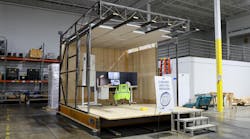Standard Adds Safety Measures for Power Doors
One year ago, the American National Standards Institute (ANSI) released a new version of the national standard for power-operated pedestrian doors, A156.10. While the standard calls for several important changes, the most significant updates address the recommended performance for activation and installation of safety sensors with automatic swinging and sliding doors.
The first major change relates to sensor performance for the swing (pull) side of a swinging door. A swinging door can be any single door or simultaneously operated pair of doors, with the exception of double-egress units, which have their own set of criteria within the standard.
According to the previous standard, an overhead presence sensor was required at the swing side of the door to project a “safety zone” (an area that when occupied will keep the automatic door from opening or closing) within and around the swing path area. Typically, this type of sensor would be header-mounted above the door.
With the new standard, an additional sensor is required at the swing side of the door to prevent the door from reactivating during the closing cycle, unless the safety zone at the swing side of the door is all clear. The intent is to prevent reactivation of the door if and only if a person should enter the swing path from the swing side during the closing cycle. Doors are permitted to re-open during the closing cycle if someone approaches the door from the proper direction.
To accomplish this, a safety beam must be installed beyond the edge of the open door. The safety beam projects an infrared light beam just beyond the edge of door. If the beam path is obstructed during the closing cycle (as someone attempts to enter from the swing side), the header-mounted sensor is re-enabled, thus preventing reactivation of the door until the door is fully closed and the swing path is all clear.
Building Teams should keep in mind that when specifying safety beams for this application, a platform will be needed to mount the sensor beyond the swing path of the door. Typical approaches involve mounting the sensor to guide rails or to a wall, when guide rails are not required.
The second major change has to do with automatic sliding doors. In the past, sliding doors relied primarily on dual safety beams to project a path of infrared light across the threshold area. If the path of the beams was interrupted, the door would automatically remain in the open position. Alternative solutions involved installing overhead sensors or a combination of safety beams and overhead sensors. The updated A156.10 standard has revised the requirements in this regard.
According to the new standard, if safety beams alone are used, a minimum of four sets of beams will now be required on the sliding door. The beams should be configured in a staggered fashion as to create a zigzag detection pattern. Although this four-beam configuration lends itself to retrofit solutions, it likely will not be the preferred choice by door manufacturers for new equipment. The likely choice will be overhead sensors on each side of the door opening, sometimes in conjunction with two sets of safety beams since some door manufacturers include those devices by default.
If only overhead presence sensors are used, then the sensor pattern at each side of the opening (approaching and departing sides) must be within three inches of the face of the door. Thus, the total maximum inactive area between the doors is three inches for each side plus the actual door thickness (typically two inches), resulting in eight inches of overall coverage. If one of the sensor patterns cannot reach to within three inches, then two safety beams must be added to the system.
The last sensor configuration option utilizes an “area” sensor, which projects an area of coverage that encompasses the entire threshold of the door opening. The primary difference between this sensor and an overhead presence sensor is that the area sensor projects a pattern into the threshold or travel path of the door, as opposed to directly adjacent to it.
The area sensor configuration has a unique performance characteristic in that the sensor must either shut off before the door starts its close cycle or must dynamically alter its pattern to acknowledge the closing door as it travels through the detection pattern. Historically, most area sensors shut off prior to the door closing, which allows the door to close without unintentionally applying a safety signal or reactivating the door. A single safety beam mounted six to 28 inches from the floor helps complement the system, as safety beams can remain on for the closing cycle. This is where the change comes in. In the past, one beam was sufficient. With the new standard, two beams will be required—one at six to 28 inches above the floor and a second at 45 to 55 inches above the floor.
These changes are probably the most significant in the history of the standard. As a member of the sub-committee for the Builders Hardware Manufacturers Association A156.10 and A156.19 Standards, I am often questioned as to why these changes were needed. As with any standard, it should reflect, to the greatest extent possible, the current technology the industry has to offer. Presence sensors have been around for quite some time, but the availability, size, aesthetics, and performance options have finally evolved to the point where they are now commonplace and quite easily accessible from many manufacturers and suppliers.
| Author Information |
| Joe DeSisto ([email protected]) has been an active member of the automatic door industry for more than 15 years. DeSisto is on the Builders Hardware Manufacturers Association sub-committee for the A156.10 and A156.19 Standards, and is also a certified trainer with the American Association of Automatic Door Manufacturers. Copies of the A156.10-2005 standard can be purchased at www.ansi.org. |

